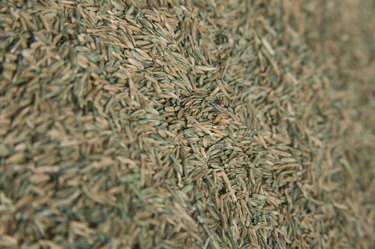
Cool-season grasses, including types such as ryegrass, bluegrass and fescue, comprise the lawns grown in the Northeast region of the United States. These turfgrass types excel in the cooler summers and survive the cold winters reliably, compared to warm-season grasses used much farther south. Across the Northeast, depending on latitude, two different lawn-seeding time periods exist: spring and late summer. Knowing when it is too late to seed depends on your location and the climatic conditions expected.
Ideal Time Frame
Video of the Day
The best time to start a new lawn from seed, or to scatter seed over an existing lawn, in the Northeast is from August 15 to September 15. This time period provides two to three months of optimal growing conditions to get the new lawn sprouts in top condition before the winter gets too cold and plants go dormant. The farther north you are located, the earlier seeding needs to take place during this one-month seeding season. Sowing seed after October 1 is a bad idea. Tender new sprouts that germinate may not be mature enough to survive the first onset of frosts and freezes in fall.
Video of the Day
Spring-Sowing Insight
Because the spring weather in the Northeast is cool and often damp, cool-season grass seed may also be scattered in early to mid-spring across the region. Spring seeding is a bit more labor intensive, as irrigation is often needed to ensure the new lawn does not succumb to drought during the increasingly warmer days of late spring and early summer. Do not scatter grass seed any later than mid-April across most of the region.
Geography Insight
In the northernmost latitudes of the Northeast, such as around the Finger Lakes and in northern New England, the summers are cooler and winters colder. The climate modifies the general rules for ideal times for sowing grass seed. In Vermont, for example, sowing grass seed in early May is still an optimal time since the summers are relatively cool. Grass seed may also be scattered in late fall after the last lawn mowing and frosts occur. The grass will not sprout but rest dormant atop the soil over the winter and sprout in spring as conditions allow. Do not scatter seed atop fallen snow in late fall, however. In southern parts of the Northeast, where summers are warmer and droughts may be more likely, timing of seeding may shift earlier in spring or slightly later in autumn.
Recommendations
Because of the varied geography, climates and soils across the Northeast, contact your county cooperative extension office for local recommendations on sowing grass seed. A horticultural agent or master gardener volunteer can answer questions about when to sow seeds based on turfgrass species used and offer guidance regarding current weather conditions. Often, grass seed can be sown almost anytime from early spring to late fall, but the amount of effort regarding irrigation or raking of fallen leaves dictates whether or not it is worthwhile.
- University of Massachusetts Extension; Best Management Practices for Lawn and Landscape Turf; Mary C. Owen, et al.; 2010
- University of Maine Extension; Establishing a Home Lawn in Maine; Lois Berg Stack
- University of Vermont Extension; Reseeding the Lawn and Other May Gardening Tips; Leonard Perry, et al.
- University of Vermont Extension; Fall Lawn Care; Leonard Perry
- University of Vermont Extension; Putting Your Lawn (and Mower) to Bed; Leonard Perry
- U.S. Department of Agriculture: Cooperative Extension System Offices